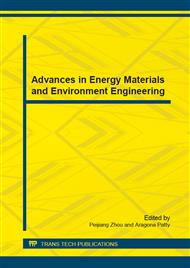p.501
p.506
p.511
p.515
p.519
p.525
p.530
p.534
p.538
Microbial Community Analysis of Underground Drinking Water Using Denaturing Gradient Gel Electrophoresis and Flow Cytometry Technologies
Abstract:
Underground water is directly used as drinking water in most rural areas of developing countries due to limitations in infrastructure. As an important indicator of drinking water quality, however, microbial quality has been largely ignored for a long time. Microbial quality poses a great threat to the safety of underground drinking water, especially in rural areas. The current study compared microbial abundance and community structure of three different water sources, i.e. underground water, Poyang Lake and Hai River, combined with flow cytometry (FCM) and denaturing gradient gel electrophoresis (DGGE). FCM results showed that the bacterial concentration of underground water is the lowest (1.037×106 cell/ml) of the three water sources, but still approximates that of the Poyang Lake. The removal rate of bacteria after filtration through a 0.45μm-pore-size filter is 98.16% in underground water. The removal rate for Poyang Lake and Hai River is much lower (i.e. 66.57% and 74.17% respectively). DGGE profiles demonstrated that the microbial community structure in underground water shares higher similarity to Poyang Lake (51.0% and 53.1% similarity for bacteria and fungi respectively) than Hai River. The microbial diversity index (i.e. Shannon-Weaver index) for bacteria and fungi are 2.906 and 2.847 respectively in underground water, which is lower than in Poyang Lake. The evenness (i.e. Simpson index) of groundwater was lowest among the three water sources tested. The results suggested that groundwater has a complex microbial community and hence it is critical to apply necessary hygienic barriers to remove microbes for the safety of underground drinking water.
Info:
Periodical:
Pages:
519-524
Citation:
Online since:
December 2014
Authors:
Price:
Сopyright:
© 2015 Trans Tech Publications Ltd. All Rights Reserved
Share:
Citation:


